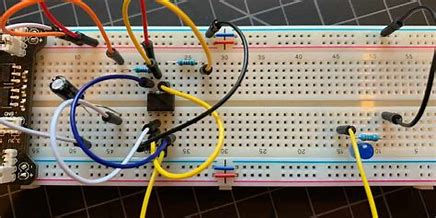Introduction to 555 timer
Introduction to 555 timer
What is 555 TIMER?
Today, we're going to explore the digital electronics application called timers or multi-vibrator timers, which are circuits that give precise periodic signals to digital circuits. In general, the multi-vibrator is a two-stage amplifier with one or more amplifiers. The 555 Timer is a widely used IC designed to generate a range of waveform outputs with the inclusion of an external RC network.
555 Timer Circuit
We have shown that multivibrators and CMOS oscillators can be conveniently built from discrete components to generate relaxation oscillators for the generation of simple square wave outputs. However, there are also dedicated ICs specifically built to precisely generate the necessary waveform output with the inclusion of only a few extra timing components. One such unit, which has been around since the early days of IC and has itself been more of an industry staple, is the 555 Timer Oscillator, which is more frequently referred to as the "555 Timer."
The basic 555 timer gets its name from the fact that there are three internally connected 5kΩ resistors which it uses to generate the two comparators reference voltages. The 555 timer IC is a very cheap, popular and useful precision timing device which can act as either a simple timer to generate single pulses or long time delays, or as a relaxation oscillator producing a string of stabilised waveforms of varying duty cycles from 50 to 100%.
The 555 timer chip is an exceptionally durable and reliable 8-pin unit that can be worked either as a very accurate monostable, bistable or astable multivibrator for a range of applications, such as one-shot or delay timers, pulse generation, LED and lamp flashers, alarms and tone generation, logic clocks, frequency division, power supplies and converters, etc.
The single 555 Timer chip in its simple form is a bipolar 8-pin mini dual-in-line package (DIP) unit consisting of about 25 transistors, 2 diodes and about 16 resistors arranged to form two comparators, a flip-flop and a high current output stage as shown below. As well as the 555 timer, the NE556 timer oscillator is also available, which incorporates two independent 555's in a single 14-pin DIP kit and low-power CMOS models of a single 555 timer, such as the 7555 and LMC555's, which use a single 555 timer.
A condensed "block diagram" describing the internal circuit of the 555 timer is given below with a brief description of each of its connecting pins to help provide a better picture of how it operates.
555 Timer Pinout
- Pin 1. – Ground pin connects the 555 timer to the negative (0v) supply rail.
- Pin 2. – Trigger, the negative input to comparator No 1. A negative pulse on this pin “sets” the internal Flip-flop when the voltage drops below 1/3Vcc causing the output to switch from a “LOW” to a “HIGH” state.
- Pin 3. – Output, output pin can drive any TTL circuit and is capable of sourcing or sinking up to 200mA of current at an output voltage equal to approximately Vcc – 1.5V so small speakers, LEDs or motors can be connected directly to the output.
- Pin 4. – Reset, this pin is used to “reset” the internal flip-flop controlling the state of the output, pin 3. This is an active-low input and is generally connected to a logic “1” level when not used to prevent any unwanted resetting of the output.
- Pin 5. – Control Voltage, this pin controls the timing of the 555 by overriding the 2/3Vcc level of the voltage divider network. By applying a voltage to this pin the width of the output signal can be varied independently of the RC timing network. When not used it is connected to ground via a 10nF capacitor to eliminate any noise.
- Pin 6. – Threshold, the positive input to comparator No 2. This pin is used to reset the Flip-flop when the voltage applied to it exceeds 2/3Vcc causing the output to switch from “HIGH” to “LOW” state. This pin connects directly to the RC timing circuit.
- Pin 7. – Discharge, the discharge pin is connected directly to the Collector of an internal NPN transistor which is used to “discharge” the timing capacitor to ground when the output at pin 3 switches “LOW”.
- Pin 8. – Supply +Vcc, this is the power supply pin and for general purpose TTL 555 timers is between 4.5V and 15V.
555 Timer Uses
- The most common application of the 555 timer oscillator is a basic astable oscillator by connecting two resistors and a capacitor across its terminals to produce a set pulse train with a time duration defined by the time constant of the RC network. But the 555 timer oscillator chip can also be connected in a number of ways to generate monostable or bistable multivibrators, as well as the more popular Astable Multivibrator.
- PWM (Pulse Width Modulation) & PPM (Pulse Position Modulation)
- Duty Cycle Oscillator.
- Lamp Dimmer.
- To provide Accurate time delays.
- As a flip-flop element.
- Digital logic probes.
- Analog frequency meters.
- Quad timer applications.

